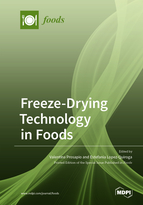Freeze-Drying Technology in Foods
A special issue of Foods (ISSN 2304-8158). This special issue belongs to the section "Food Engineering and Technology".
Deadline for manuscript submissions: closed (30 November 2019) | Viewed by 59983
Special Issue Editors
Interests: drying; rehydration; microstructure; shelf-life; process optimisation; food properties
Interests: food manufacture; mathematical modelling; food process design and optimisation; transport phenomena; phase change; structuring processes; soft matter; sustainable food chains
Special Issue Information
Dear Colleagues,
We are pleased to invite you to submit a contribution for a Special Issue titled “Freeze-Drying Technology in Foods”. Submitted manuscripts may be original research papers describing complete investigations, or review articles highlighting recent achievements in freeze-drying of foods.
Please note that papers in this area are not limited to experimental studies but can include all aspects concerning modelling, control, and optimisation. We expect contributions focusing on the effect of formulation and processing conditions on microstructure, function and quality, and freeze-drying processes in combination with other techniques (e.g., osmotic, microwave, blanching). We also hope to include works that describe model-based approaches to process design and optimisation leading to more sustainable and efficient processes.
This Issue will provide an update on the most recent research and development in the area of freeze-drying technology, offering an overview of oncoming challenges and opportunities on the topic.
Dr. Valentina Prosapio
Dr. Estefania Lopez-Quiroga
Guest Editors
Manuscript Submission Information
Manuscripts should be submitted online at www.mdpi.com by registering and logging in to this website. Once you are registered, click here to go to the submission form. Manuscripts can be submitted until the deadline. All submissions that pass pre-check are peer-reviewed. Accepted papers will be published continuously in the journal (as soon as accepted) and will be listed together on the special issue website. Research articles, review articles as well as short communications are invited. For planned papers, a title and short abstract (about 100 words) can be sent to the Editorial Office for announcement on this website.
Submitted manuscripts should not have been published previously, nor be under consideration for publication elsewhere (except conference proceedings papers). All manuscripts are thoroughly refereed through a single-blind peer-review process. A guide for authors and other relevant information for submission of manuscripts is available on the Instructions for Authors page. Foods is an international peer-reviewed open access semimonthly journal published by MDPI.
Please visit the Instructions for Authors page before submitting a manuscript. The Article Processing Charge (APC) for publication in this open access journal is 2900 CHF (Swiss Francs). Submitted papers should be well formatted and use good English. Authors may use MDPI's English editing service prior to publication or during author revisions.
Keywords
- freeze-drying
- process design
- rehydration, modelling
- life cycle assessment
- energy saving
- efficiency
- microstructure
- food quality
- encapsulation
- processes combination







